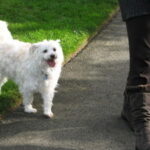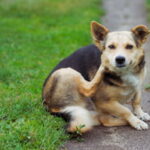Here are some of the most common bad habits and ways to eliminate them:
* Barking at visitors. Most people don’t mind if their dog barks when she hears someone at the door. They and their visitors will become annoyed if the dog continues to bark after the visitors are invited in. To stop the barking, put your dog in a “down, stay” position: most dogs will not bark when they are lying down. If the dog continues to bark, select a command such as “Hush.” When she quits barking, praise her by saying “Good hush.” This may need to be repeated several times.
* Jumping on people to greet them. Dogs jump up so that they can get closer to your face when they greet you – if you get down to a puppy’s level when you greet her, she may never start jumping up. If she already has a confirmed jumping habit, the easiest way to stop her is to tell her to “Sit” when she meets people but before she begins to jump up.
* Licking. Some people don’t mind if their dog licks their hands, or even faces. Other people find it disgusting. If you don’t want your dog to lick you, get up and walk away from her when she tries it.
* Pushing through doors. People often let their dogs get away with shoving ahead of you and pulling their leash to get out the door because they think the dog is too excited to listen to them. However, an out-of-control dog may get away and dash into the street. Put your dog on the leash before you go to the door and make her sit and stay while you open the door. After you have gone through, invite her to follow you.
* Chewing your belongings. The best wayto avoid chewing by a new puppy or adult dog is to leave them unsupervised only in areas where there is nothing to damage; she must also have chew toys that she knows are for her. If there is no area in your house that is chew-proof, the best answer is crate training. If you see your dog beginning to chew something inappropriate, stay calm: yelling at her will probably just teach her not to chew on things when you are around. Take away what she is chewing on while saying a firm, “No.” Then give her one of her own chew toys and when she starts chewing on it, praise her.
* Pleading for attention. Many dogs act as though it is your sole function in life to give them attention, and it is certainly a pleasure for you to spend time petting and grooming them. However, if your dog believes she can demand attention from you whenever she wants it, she will think she can set the rules. If you are busy and your dog begins to pester you, put her in a “down, stay” position. After a few minutes of her staying quiet, praise her for obeying.
* Digging up the yard. Digging is natural behavior for dogs. They will bury food or make a cool place to lie in the summer. You can choose either to have a no-digging rule or to set aside an area where your dog is allowed to dig. If you want to prohibit digging, you will have to supervise your dog’s outings in the yard, because some dogs will dig even if they are on a leash. If you want to allow your dog to dig, designate a small area and encourage her to dig there. If you have previously yelled at her for digging, she may not want to dig while you are there. You may have to dig a little bit yourself to show her it is okay; you also might bury a treat or a bone for her to find. She may still want to dig in other areas, so you will have to continue to supervise her in the yard.
* Aggression. All dogs have some aggressive tendencies. If your dog has a serious aggression problem, you should seek help from a professional trainer or animal behaviorist. However, most aggression problems can be avoided if your new puppy is properly socialized. Fear sometimes leads to aggression, which can also be reduced by socialization.
* Fear. If your dog has been socialized and thoroughly trained, she is unlikely to be fearful in most situations. Even so, dogs – like humans can be afraid of new or strange situations. To handle these situations, you can use several tactics: give your dog a command, such as “Sit,” and then praise her. She knows that nothing bad will happen if she obeys a command, and listening to her owner will take her mind off whatever is making her afraid. If a strange object is causing the fear, you can encourage your dog to believe that she is safe by casually inspecting it yourself. If she sees that you are not afraid, she will believe she is safe. If your dog is extremely fearful, you should consult a professional trainer or animal behaviorist.
* Submissive behavior. Some dogs are naturally submissive and lack confidence. Instead of greeting their owners happily, they will crouch submissively and sometimes even urinate out of fear, and being angry with them only makes the problem worse. Early socialization and obedience training will build your dog’s confidence, although a genetically submissive dog may always be somewhat afraid. Don’t confuse submissive behavior with guilt – if you just found the garbage all over the kitchen, your dog knows you are angry and she will react by acting submissively. She doesn’t associate the garbage with your anger, however, and punishment will only make her more afraid and more submissive.
* Meeting other dogs. Don’t feel that your dog has to greet every other dog she meets on the street; choose which dogs you let her approach. Ask the owner of the other dog if it’s okay for them to interact. Don’t pull on the leash when your dog approaches the other dog: doing so will interfere with her natural body posture and may make her think that she should be protective. Do be alert to signs from both dogs – if one dog begins to tense up, separate them without making a fuss, which may encourage their protective instincts.
* Stealing off countertops. If your dog steals food off a countertop, and you scold her when you catch her in the act, she will learn not to take food when you are there. If you want to teach her never to steal, even when she is unsupervised, you will need to attach a container of water or some cans that will make a loud noise to the food. When she pulls the food off the counter, she will associate the water or noise with her theft and probably decide not to try it again.
No matter how well your dog training is, don’t expect her to be perfect 100% of the time after all, the old adage about no one being perfect is absolutely true. But give your dog praise, patience and perseverance (the three P’s of dog training), and you will have a well-mannered dog most of the time!






